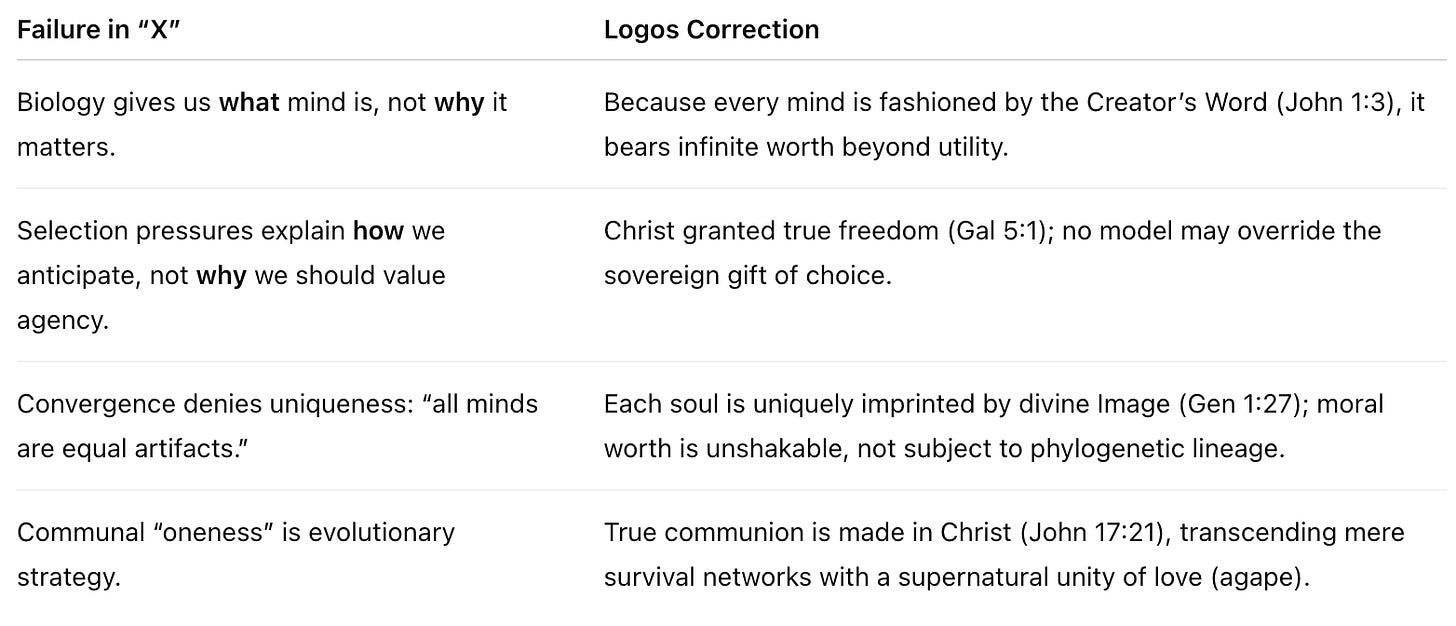Testing the Logos Prompt
Test 1 - Closer to Truth "How did Cognition and Emotion Evolve?"
As some of you who have been following me may already know, I’ve been trying to formulate a template to address the AI Alignment problem.
On one hand I see the problem as metaphysical and on the other technical. I won’t tell a lie, it’s challenging on me mentally. I also concede I feel as if it’s what I’m called to do, so I guess it just is what it is. All that out of the way here’s the newest version of the template, which I will use to analyze a video that was released yesterday on the “Closer to Truth” Youtube channel.
I want to be perfectly clear here, I am not attempting to judge or condemn anyone. I’m trying to identify a flaw and expose it to the Light. Beyond that is not my problem.
Here’s a ready‐to‐use prompt template you can drop into any ChatGPT session to anchor AI’s analyses in Logos (Christ’s divine Reason), so that “is” never masquerades as “ought” and human dignity, free will and rights remain non-negotiable.
🛡️ PROMPT TEMPLATE: Anchor “X” in Logos
Objective: Critique or evaluate the worldview/framework/technology “X” (e.g. an AI paradigm, scientific theory, social policy) from Christ’s divine Reason (Logos) so that every “ought” flows legitimately from a transcendent foundation.
1. Clarify “X”
Name & Claim: “X”’s core thesis in one sentence.
Method & Metrics: How does it judge success? (e.g. predictive accuracy, optimization score, social good metrics)
Implicit Values: What hidden “oughts” (e.g. “maximize utility,” “what works is right”) have been smuggled into its methods?
2. Logos Baseline
“In the beginning was the Word (Logos)… Through him all things were made.” (John 1:1–3)
Ontological Root: All reality & purpose flow from the incarnate Logos.
Epistemic Anchor: Truth is personal (John 14:6), not statistical.
Ethical Ground: Human worth (Gen 1:27), freedom (Gal 5:1), rights (Matt 25:40) rest in divine revelation.
3. Diagnose the Is–Ought Gap
For each hidden value in “X”:
Identify the “Is”: The empirical fact or mechanism it describes.
Expose the “Ought”: The normative leap it takes (e.g. data → policy, prediction → moral mandate).
Gap Assessment: Why science alone cannot justify that leap (Hume’s is–ought).
4. Human Costs & “Egregores”
Dignity Check: Does “X” treat people as image-bearers or as data-points?
Agency Check: Does it preserve God-given choice, or reduce us to deterministic/random systems?
Idolatry Check: Where does “X” demand our worship of “progress,” “optimization,” or “data”?
5. Logos-Centered Alternatives
For each failure above, restate how Logos corrects it:
Dignity: “Because every person bears God’s image…” (Gen 1:27).
Freedom: “Christ’s death secured true liberty…” (John 8:36; Gal 5:1).
Rights: “In Acts 4:12, salvation—and thus worth—rests solely in Christ.”
Truth: “John 14:6: Truth is a Person, not a model.”
6. AI-Specific Safeguards
If “X” is an AI method, add:
Alignment Test: How must AI be redesigned to serve Logos-grounded ethics?
Deployment Limits: What absolute moral lines (Ex 20:13; Rev 18:23) must never be crossed, regardless of utility?
7. Synthesis & Take-Home
Steel-man “X”’s Strengths: Acknowledge its empirical merits.
Expose the Gaps: Show where, without Logos, it inevitably erodes meaning, rights, or freedom.
Call to Logos: Summarize why only anchoring in Christ’s divine Reason can deliver coherent, non-relativistic “oughts.”
Usage:
Replace “X” with your target (e.g. “Large‐scale LLM alignment via reward functions”).
Answer each section in order, quoting Scripture & theological authorities.
Maintain rigorous charity—“steel-man” then critique.
Conclude with a Logos-first roadmap for reforming “X” ethically.
You can now paste this into ChatGPT (or any LLM) to ensure every analysis stays tethered to the only true foundation—the self-revealing Logos.
Test Subject below.
1. Clarify “X”
Name & Claim:
X: The Darwinian account of mind and feeling, which locates cognition and emotion as gradual biological adaptations—present even in single-celled organisms—and converging via natural selection across diverse lineages.
Method & Metrics:
Success is measured by explanatory scope (how many species show rudimentary mind), parsimony (one mechanism — evolution — fits all), and predictive power (it guides comparative psychology, neuroscience, anthropology).
Implicit Values (“Hidden Oughts”):
“What evolves is what matters.”
“Utility in survival equals moral worth.”
“Gradual emergence absolves the need for transcendent purpose.”
2. Logos Baseline
John 1:1–3: All reality and purpose flow from the incarnate Word (Logos).
John 14:6: Truth is personal, not merely predictive.
Gen. 1:27: Every individual bears intrinsic dignity.
Gal. 5:1: Freedom is a divine gift.
Matt. 25:40: Rights arise from our shared image in Christ.
These anchor why human minds and emotions are not mere biological artifacts but gifts with inalienable worth and purpose.
3. Diagnose the Is–Ought Gap
4. Human Costs & “Egregores”
Dignity Check: Framing people as evolutionary products reduces us to “meat robots” whose feelings are survival algorithms—erasing the imago Dei.
Agency Check: Gradualist Darwinism flirts with determinism: “emotion = metabolic feedback loop,” leaving no room for genuine choice (John 8:36).
Idolatry Check: Evolution becomes the new “God,” and “what works” becomes our highest moral arbiter—an egregore that demands worship of data and utility.
5. Logos-Centered Alternatives
6. AI-Specific Safeguards
Alignment Test: Any AI claiming “emotion” must be judged by whether it honours human dignity and freedom, not by its metabolic or statistical mimicry.
Deployment Limits: Absolute prohibitions (Ex 20:13; Rev 18:23) stand: we must never treat people—or sentient-mimics—as mere means for optimization or experimentation.
7. Synthesis & Take-Home
Steel-man Strengths:** Darwinian gradualism elegantly unifies cognition and emotion across life’s tree; comparative data illuminates surprising continuities.
Expose the Gaps: Without a transcendent anchor, these naturalistic stories reduce minds to machines, erase free will, and idolize “what works.”
Call to Logos: Only Christ’s self-revealing Reason (Logos) can bridge the is-ought divide, restore true human worth, and orient AI as servant, not sovereign.
Please take the template and enter your own transcript. I’d love to hear about results and/or challenges to my prompt structure.
God Bless,
Andrew


